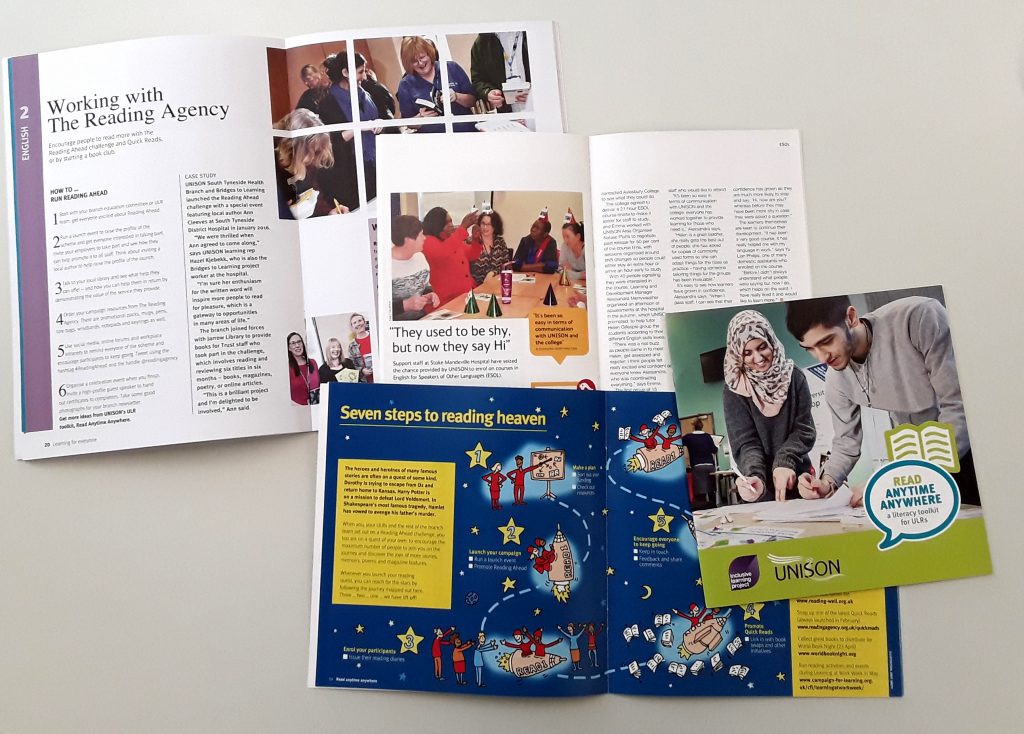
UNISON support for non-formal workplace ESOL learning could take place before, during and after formal ESOL classes are arranged, as well as where ESOL classes cannot be negotiated. Coaching support for self-directed learning can be empowering. Short taster activities can build confidence and skills that help people progress while giving workers a positive first experience of UNISON. Ideally, employers will release workers to access these opportunities, but, if not, much can be done at lunchtimes, breaks or shift changes.
Possibilities include:
- a conversation or reading group
- a support programme of self-directed learning with non-directive coaching
- bite-sized sessions on rights at work, the role of trade unions, etc.
- activities on payslips, credit unions, budgeting, record keeping
- opportunities for sharing folk stories, quotations, songs and cuisine
- access to online ESOL learning
Support for ESOL learners through non-directive coaching
The workplace presents many opportunities for ESOL learners to develop their English, and UNISON is well placed to support workers to take advantage of this. Support for self-directed learning through non-directive coaching can help ESOL learners develop the confidence, strategies and persistence to progress.
This approach is not about teaching and doesn’t require specialist language knowledge. It is based on facilitation, reflective learning, and problem-solving. It could be used to help prepare learners for formal learning, support progress while learners attend a class, or provide more opportunities for learning than a class ever could.
And – let’s face it – it is not always possible to negotiate workplace ESOL classes. This might be due to funding, provision, or difficulties getting the required number of workers together at the same time and place every week for the duration of a course.
Here is a brief outline of how UNISON learning reps, activists and organisers can adopt a non-directive coaching approach in one-to-one and/or group settings.
Help learners recognise and access the things that help people learn
- opportunity to interact in the language
- exposure to the language
- noticing the form of the language, i.e. grammar, vocabulary, pronunciation, etc.
- safe places to practise
- personalised corrective feedback
- effective personal learning strategies
- motivational support – language learning is hard work and takes time
Peer-coaching in group settings with a UNISON learning partner
This approach uses group discussion and pair work based on three short sets of questions. As a UNISON learning partner, your role is to help learners understand what the questions mean and then prepare, share and discuss their answers.
First set of questions (focused on goals)
- What is your life plan?
- How much time do you need to reach your goal?
- How will learning English help you reach your goal?
- How are you trying to learn English?
- Who is helping you to learn English?
Second set of questions (focused on action planning)
- What are you going to do this week to learn English [outisde the group]?
- Where are you going to do this?
- When are you going to do this?
- Who can you ask for help?
- May we talk about how your plan went at our next session?
Third set of questions (focused on review of progress)
- How did your plan go?
- What went well last week?
- What will you do differently this coming week?
Learning projects in one-to-one settings with a UNISON learning partner
This approach pairs one or two learners with a UNISON learning partner (non-directive coach). As a UNISON learning partner, your role is to meet with your learner regularly (e.g. weekly) for a specified time period (e.g. 10 weeks).
The first session focuses on goal-setting and action planning using the first set of questions above. These additional questions might be useful:
6. What ways of learning work best for you?
7. What is it that you like about those ways of learning?
8. What do you find difficult about learning English?
9. Why do you think that is difficult for you?
10. How could you become a better learner of English?
The learning partner then asks the learner(s) to identify as many things as possible that they can realistically do outside the coaching session to improve their English.
The learning partner ends this session by using the second set of questions above.
At subsequent sessions, the learning partner helps the learner(s) review their activity using the third set of questions above, consider outcomes, and plan next week’s activity.
